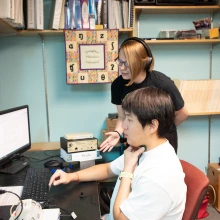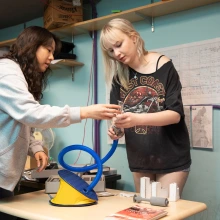Innovative Airflow Research at U of A Highlights Noninvasive Speech Data Collection

From left, student Adrian Onyx and Natasha Warner, head of the Department of Linguistics
Mackenzie Virdee
The Douglass Phonetics Lab in the College of Social and Behavioral Sciences is a hub for research and teaching in articulatory and acoustic phonetics, speech perception, psycholinguistics, and speech technology. Natasha Warner, head of the Department of Linguistics and director of the Douglass Phonetics Lab, offers her students valuable hands-on experience and the opportunity to engage in phonetics research.
"At the Douglass Phonetics Lab, both undergraduate and graduate students do research on how the human vocal tract creates speech, what information is in the sound waves in speech, and how listeners understand what they hear,” Warner said. “Students in the lab are working on the reduced, 'sloppy' speech that we all use in conversation, where many sounds are deleted or changed, and studying how listeners understand this messy but normal speech.”
Junior Adrian Onyx has taken advantage of the lab to conduct research in his chosen area of interest. An undergraduate linguistics major, Onyx was put in charge of figuring out a new piece of equipment after it arrived at the lab.

Students Ki Woong Moon and Adrian Onyx
Mackenzie Virdee
“Onyx has taken charge of learning how to use a new piece of equipment in the lab: a set of masks and meters that measure how much air is flowing out of the mouth and nose while a person talks,” Warner said. “This helps us understand how speakers of various languages make the sounds that they use to communicate in a given language.”
Warner emphasizes Onyx's initiative in taking charge of learning a complex new piece of equipment while still being an undergraduate student.
“What's so remarkable to me is that Adrian is an undergrad, and we've just put him in charge of figuring out how to use this pretty complex piece of equipment, with very little supervision,” Warner said. “He has grabbed onto this project and found ways to learn whatever he needs to, independently, in order to make it work. He's done a fantastic job on that.”
Onyx’s interest in airflow research began with a desire to repurpose existing technology for new applications. His focus is to make the data collection process less intrusive and more comfortable for research participants.
“My research focuses on taking this medical device and figuring out how to make sure linguists can use it to figure out how humans communicate with each other,” Onyx said.
Incorporating this approach is part of a broader effort to apply advanced technology in the study of human language.
The new device offers a level of convenience that is useful for fieldwork. It can be hooked up to a computer, making it highly portable. This allows researchers to travel to communities for data collection rather than requiring participants to visit a lab.
Such research is particularly significant for studying rare languages. If a speaker of an endangered language wanted to analyze how they produce certain sounds, they wouldn’t want to use invasive equipment that goes inside the mouth. Instead, a simple, oxygen mask-like device provides a much more comfortable and efficient alternative.
“A lot of languages only have elderly speakers left, and we want to make sure the process goes as smoothly as we can for both researchers and the participants, and such groups may otherwise not be researched if this technology is not developed,” Onyx said.
According to Warner, research shows that the technology is also useful for studying how non-native speakers pronounce sounds in languages they are learning. For example, a former student in the lab used an earlier version of the equipment and found that non-native learners of Spanish put more air through while trying to start a trilled “r” sound than natives do.

From left: Students Song Kim and Miriam Kaylor
Mackenzie Virdee
“We’re not the first lab to use this kind of equipment — or even something similar,” Warner said. “We actually had an earlier version of this type of device that we used years ago to record elderly speakers of an endangered language — Scottish Gaelic — in Scotland.”
The original device, while portable and field-ready, eventually stopped working. Instead of buying a new version from the same company, they bought a new system with different features from another company.
Through his research, Onyx’s objective is to ensure that the device functions as intended and can be adopted by linguists to analyze how people produce specific sounds in different languages. His ultimate goal is to make data collection easier and more accessible while preserving the integrity of linguistic research.
Onyx has faced challenges in understanding medical terminology and complex equations while exploring the device’s potential for linguistic research. His goal is to adapt it for more efficient data collection, benefitting both researchers and participants.
“I’m hoping that by making data collection less invasive, it will allow for more data to be gathered overall and be able to safely get data from high-risk groups who would otherwise be excluded due to the risk,” Onyx said. “Such groups could be elders of Native communities.”
Beyond its research impact, this project has had a personal effect on Onyx as well.
“Before this, I was unsure if I was really fit for the academic world, and I wasn’t sure if I wanted to attend graduate school,” Onyx said. “But, with how far I have gotten, and all the support I have received along the way, I am very sure that I want to go.”
##

